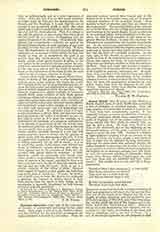

Cursor Mundi (THE RUNNER OF THE WORLD), a Middle-English poem of nearly 30,000 lines containing a sort of summary of universal history. From the large number of manuscripts in which it is preserved, it must have been exceptionally popular. It was originally written, as certain peculiarities of construction and vocabulary clearly show, somewhere in the north of England, but of the author nothing can be learnt except the fact, which he himself tells us, that he was a cleric. He must have lived at the close of the thirteenth and at the beginning of the fourteenth century, and his poem is conjecturally as-signed to about the year 1300. In form it is written in eight-syllabled couplets, but in his account of the Passion of Christ the author adopts a new metre of lines of eight and six syllables rhyming alternately. Although the poem deals with universal history, the author contrives to give some sort of unity to his work by grouping it around the theme of man’s redemption. He explains in an elaborate prologue how folk desire to read old romances relating to Alexander, Julius Caesar, Troy, Brutus, Arthur, Charlemagne, etc., and how only those men are esteemed that love “paramours”. But earthly love is vain and full of disappointments.
Therefore bless I that paramour [i.e. Our Lady]
That in my need does me soccour
That saves me on earth from sin
And heaven bliss me helps to win.
Mother and mayden never-the-less Therefore of her took Jesu flesh.
He goes on to say that his book is written in honor of Mary and purposes to tell about the Old and the New Law and all the world, of the Trinity, the fall of the Angels, of Adam, Abraham, and the patriarchs, then of Christ’s coming, of His birth, and of the three kings, etc., of His public life and of His Passion and Crucifixion, and of the “Harrowing of Hell“. Thence he will go on to the Resurrection and Ascension, the Assumption of Our Lady, the Finding of the Cross, and then to Antichrist and to the Day of Doom. As a. sort of devotional appendix he also proposes to deal with Mary’s mourning beneath the Cross and of her Conception. This work he has undertaken.
In to English Tongue to rede
For the love of English lede [people]
English lede of England
For the common [folk] to understand.
This ambitious program is faithfully carried out with considerable literary skill and a devotional feeling quite out of the common. The author shows himself to have been a man of wide reading. Although his main authority is the “Historia Scholastica” of Peter Comestor he has made himself acquainted with a number of other books in English, French, and Latin, and his work may be regarded as a storehouse of leg-ends not all of which have been traced to their original sources. Special prominence is given throughout the work to the history of the Cross which for some reason (possibly because St. Helena, the mother of Constantine, was reputed to have been of British birth) was always exceptionally popular in England.
After commending the author’s “keen eye for the picturesque”, a recent critic, in the “Cambridge History of English Literature”, remarks, “The strong humanity which runs through the whole work is one of its most attractive features and shows that the writer was full of sympathy for his fellow-men.”
HERBERT THURSTON

